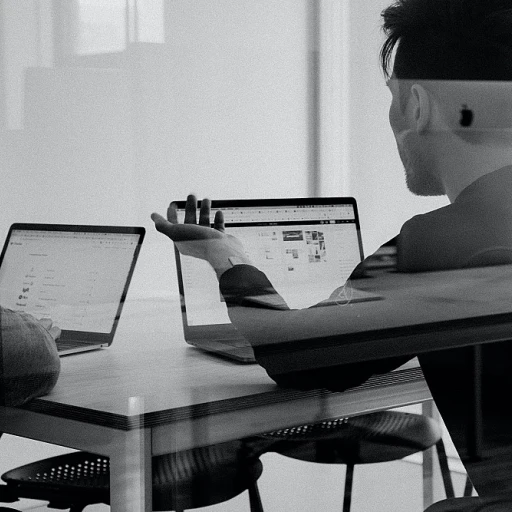
The rise of predictive analytics in HR
Predictive analytics making waves in HR
In today's fast-paced world, the intersection of artificial intelligence in human resource management and predictive analytics is transforming HR. Businesses are keen to tap into this potential, revolutionizing how they manage their employees. Here's how predictive analytics is becoming a game-changer for HR departments.
Data-driven decision making in HR
HR professionals have traditionally relied on intuition and past experience in making hiring, promotion, and termination decisions. But now, with data analytics playing a central role, decisions are becoming more informed and objective. For instance, a study by Deloitte showed that 75% of companies are confident that using analytics enhances their business decisions.
Accuracy and insights
Predictive analytics isn't just about crunching numbers; it’s about deriving meaningful insights from vast data sets. With the right tools, HR can forecast turnover rates, identify potential high performers, and even predict which candidates will accept job offers. According to Gartner, organizations leveraging predictive analytics have seen up to a 41% decrease in turnover rates.
Embracing the future of HR
As we move forward, the integration of predictive analytics in HR will only grow. Companies like Google and Microsoft are already setting the pace, using sophisticated models to predict employee performance and engagement levels. By aligning data with HR strategies, businesses can stay ahead of the curve, fostering a proactive rather than reactive HR approach.
Understanding predictive analytics: A primer
Deciphering predictive analytics in HR
When we step into the realm of HR and data analytics, predictive analytics stands out as a fascinating component. Essentially, predictive analytics uses historical data along with various algorithms to forecast future trends. In HR, this process helps management predict outcomes related to employee performance, turnover, and engagement.
How predictive analytics works
Predictive analytics employs a combination of statistics, data mining, and machine learning. It identifies patterns from past data and extrapolates these insights to make informed predictions. For instance, IBM's Watson uses predictive analytics to forecast employee attrition, helping businesses proactively address retention issues. A 2019 survey by SHRM reported that 32% of organizations were already using predictive analytics to some extent in their HR functions.
Tools and techniques
Leading companies have developed robust tools for predictive analytics in HR. SAP SuccessFactors provides comprehensive analytics tools enabling HR professionals to gain insights into workforce trends. Microsoft's Power BI is another tool that helps convert raw data into meaningful insights. These tools often come equipped with interactive dashboards and visualization capabilities, making data easier to interpret and actionable for human resources management.
Impact of predictive analytics on decision making
Predictive analytics has significantly influenced the decision-making process in HR. By offering reliable forecasts, it allows businesses to make data-driven decisions. For example, predictive models can estimate the likelihood of an employee leaving the company, thus giving managers the chance to implement engagement strategies proactively. According to Gartner, businesses leveraging predictive analytics reported a 15% increase in employee retention rates.
Real-world examples
Besides IBM, other companies have successfully implemented predictive analytics in HR. Deloitte, for instance, uses these techniques to predict employee performance and potential flight risk, aligning their talent management strategies accordingly. As a result, they improved their talent retention by 12% within a year. It's evident that the application of predictive analytics not only streamlines operations but can profoundly affect the bottom line.
Real-world applications of predictive analytics in HR
Using predictive analytics to foresee employee turnover
Predictive analytics isn't just a buzzword; it's a powerful tool that companies like Google and Microsoft use to forecast employee turnover. According to a study by Deloitte, companies leveraging predictive analytics can reduce their turnover rates by up to 50%. This form of analytics evaluates patterns and trends in HR data to foresee which employees are most at risk of leaving. By identifying these risks, businesses can take proactive measures to retain their talent.Enhancing talent acquisition and recruitment
Talent acquisition is another domain where predictive analytics shines. Using data and advanced algorithms, companies can predict the success and tenure of potential hires. For example, IBM has successfully implemented AI in their HR processes to screen resumes and predict candidate performance even before the first interview. This approach not only saves time but also improves the quality of hires. In fact, according to SHRM, companies utilizing predictive analytics in recruitment experience a 30% improvement in hire quality.Optimizing workforce planning
HR predictive analytics also plays a crucial role in workforce planning. By analyzing market trends, employee performance, and skill gaps, companies can make data-driven decisions about future hiring needs. SAP’s workforce analytics solution is a prime example of how businesses can use data to anticipate future workforce requirements and align them with organizational goals. This proactive approach helps in mitigating risks associated with talent shortages and helps ensure a steady pipeline of skilled employees. Gartner reports that 70% of employers now use some form of workforce planning based on predictive analytics.Boosting employee engagement and satisfaction
Employee engagement and satisfaction are deeply influenced by predictive analytics. By analyzing data from employee surveys, social media, and performance metrics, businesses can identify issues affecting morale and take corrective actions. L&D strategies can be tailored using predictive insights to enhance employee growth and satisfaction. According to a report by Performance Excellence Gartner, organizations using predictive analytics to monitor and improve engagement have seen a 26% increase in employee satisfaction levels.Informing strategic HR decisions
Strategic HR decisions are critical for the long-term success of any organization. Predictive analytics provides the insights needed to make informed decisions about promotions, training programs, and career development paths. This ensures that employees are nurtured and retained, and the right people are in the right roles. Experts believe that HR analytics help in making strategic decisions that align closely with the company’s objectives. This data-driven decision making leads to better resource management and organizational efficiency. For more insights on predictive analytics in HR, checkout the comprehensive guide to the top HR analytics events and trends in 2023.Predictive analytics for employee engagement and retention
Importance of employee engagement in modern HR
Employee engagement doesn't just sound good on paper; it's a real game-changer for companies. Gallup found that companies with highly engaged teams show 21% greater profitability. That's huge! But here's the catch: according to Gallup, 51% of employees are "not engaged" and 13% are "actively disengaged," meaning they're not only unproductive but also likely to spread negativity. This disconnect can cost U.S. companies up to $550 billion annually in lost productivity.How predictive analytics can improve engagement
Predictive analytics offers a path out of this mess. Imagine knowing in advance who among your employees might be considering an exit, or whose morale is dipping. Adobe has leveraged predictive analytics to pinpoint employees at risk of leaving and engages them proactively, reducing turnover drastically. Using tools like SAP SuccessFactors and IBM’s Watson analytics, companies can foresee potential dips in engagement and address them before they escalate. This proactive strategy can help reshape retention and satisfaction across the board.Case study: hilton's approach to predictive analytics
Hilton Worldwide implemented a predictive model to tackle engagement issues. They used data from employee surveys, performance metrics, and turnover rates to forecast potential disengagement. Post-analysis, Hilton introduced changes like flexible work hours, and development programs, and saw a marked improvement in their engagement scores. Employee turnover dropped by 5%, directly improving their bottom line.Addressing employee concerns with actionable insights
Incorporating predictive analytics requires more than just fancy algorithms. It’s about making the data actionable. For instance, if the data shows that employees in a specific department are less engaged, companies need to dig deeper. Are these employees feeling unappreciated? Is the workload unreasonable? By extracting insights and acting on them, businesses can address issues head-on. Google uses People Analytics to understand which management styles work best. They analyzed data on manager performance, conducting interviews, and then trained managers on the identified best practices. This initiative increased manager satisfaction scores and overall employee engagement.Metrics to track for measuring engagement
To effectively use predictive analytics, companies must track various metrics:- Net Promoter Score (NPS): Measures the likelihood of employees recommending the company as a good place to work.
- Employee Satisfaction Scores: Frequent surveys can gauge real-time engagement levels.
- Turnover Rates: Identifies trends and red flags in specific departments or teams.
- Productivity Levels: Measures how engagement affects day-to-day output.
Conclusion
Predictive analytics offers an exciting avenue for transforming employee engagement. By making data-driven decisions, businesses can not only improve morale but enhance productivity and profitability. It’s time to harness the power of predictive analytics for a more engaged and resilient workforce.Predictive analytics in performance management
Using predictive analytics to boost employee performance
Harnessing predictive analytics for performance management isn’t merely futuristic; it's a present-day reality transforming how companies operate. In a survey conducted by SHRM, 71% of HR professionals reported that incorporating data analytics into performance management offers more accurate assessments and productivity boosts.
Data-driven performance metrics
Analytics help professionals measure and improve employee performance through a variety of data-driven metrics. Metrics can be derived from a plethora of sources: sales figures, customer feedback, project completion rates, and attendance records. According to Gartner, businesses using predictive analytics saw a 25% rise in employee performance.
Case study: ibm's predictive performance management
IBM is a solid example of how predictive analytics revolutionizes performance management. Using workforce analytics, IBM managed to predict and reduce performance-related issues before they escalated. As a result, the company reported a 20% improvement in overall employee productivity, as detailed in their report.
Challenges and best practices
Implementing predictive analytics comes with its share of challenges, including data privacy concerns and ensuring the accuracy of predictive models. Best practices involve a data-driven approach, collaborating with data science experts, and using a flexible performance management strategy. For practical tips, consider reading this article on how to leverage big data in HR.
Expert insights
Josh Bersin, a renowned HR analyst, emphasizes the impact of predictive analytics on performance management. He states, “Companies that adopt predictive analytics within their HR departments can not only foresee potential performance dips but can also tailor interventions, boosting overall productivity.”
Challenges and controversies in predictive HR analytics
Data privacy and ethical dilemmas
One of the significant challenges faced in predictive HR analytics is data privacy. The General Data Protection Regulation (GDPR) in Europe and the California Consumer Privacy Act (CCPA) in the U.S. set stringent guidelines on how personal data should be handled. Companies must ensure that employee data is securely stored and used ethically, preventing misuse or unauthorized access.
In the revolution of HR analytics, balancing the benefits of predictive insights with the necessity to respect privacy remains a crucial concern. Violations of these laws can result in heavy fines and damage to a company’s reputation.
Data accuracy and quality
Another hurdle is the integrity and accuracy of the data being analyzed. Predictive analytics relies heavily on high-quality data. Poor data quality can lead to misleading conclusions, negatively influencing decision-making. According to IBM, bad data costs U.S. businesses approximately $3.1 trillion annually. Ensuring the dataset is clean, accurate, and up-to-date is paramount for the success of predictive models in HR.
Bias in predictive models
Bias in predictive models is a controversial issue. Algorithms are not infallible and can perpetuate or even exacerbate existing biases. For example, if historical data used in talent acquisition reflects gender or racial bias, predictive models may inadvertently continue these patterns. Dr. Cathy O'Neil, a data scientist, emphasizes that models can encode bias into decision-making processes, inadvertently promoting discrimination.
Understanding and trust among employees
Employees may feel uneasy about being monitored through sophisticated analytics. It's essential for companies to maintain transparency and communicate how data will be used. A 2019 survey by Deloitte found that 64% of employees were uncomfortable with their employers collecting and analyzing data about their work. Building trust and ensuring employees are on board with predictive analytics initiatives is key to successful implementation.
Integrating predictive analytics with existing HR systems
Integrating new predictive analytics tools with existing HR systems can be technically challenging. According to a report by George Westerman at MIT, about 70% of large-scale data projects fail to meet their expectations due to integration issues. Companies need to invest in robust infrastructure and skilled personnel to streamline this process, ensuring the new systems can work seamlessly with existing HR operations.
Future trends in HR and predictive analytics
Emerging technologies in predictive analytics for HR
Predictive analytics is already transforming HR by identifying potential employee turnover, optimizing recruitment processes, and enhancing performance management. But what does the future hold?
AI-powered predictive insights
Artificial intelligence (AI) is set to take predictive analytics to the next level. AI can analyze massive datasets more efficiently than traditional methods, providing deeper insights. According to Gartner, by 2025, AI will generate data-driven insights that will cut down turnover rates by 20%. This could be a game-changer for HR departments struggling with retention.
Integrating wearables and IoT
The Internet of Things (IoT) and wearable technology offer new possibilities for HR. Devices that monitor stress levels, physical activity, and other health metrics can provide data for predictive analytics. This can help organizations proactively address employee well-being and reduce burnout. The total number of employees using such devices is projected to reach 75 million by 2025, according to a Cisco study.
Blockchain and secure data integration
Data security remains a crucial concern for HR analytics. Blockchain technology can offer a solution by ensuring secure and tamper-proof data integration. Implementing blockchain can enhance data privacy and compliance, fostering trust in predictive analytics. This technology is already being piloted by companies like IBM and Microsoft.
Data democratization and accessibility
The future of HR will also see a shift towards data democratization, making analytic tools accessible to all levels of management. This will empower managers with actionable insights to make data-driven decisions. Research by Gartner indicates that democratized data can improve decision-making efficiency by 30%.
Sustainability analytics for HR
Sustainability is becoming a priority for many organizations, and HR is no exception. Predictive analytics can help HR teams measure and optimize their sustainability efforts, from tracking environmental impact to promoting social responsibility. Companies embracing sustainability analytics are reported to see a 15% increase in employee loyalty, according to a study by Deloitte.
The future of predictive analytics in HR is brimming with potential. By leveraging emerging technologies, organizations can not only enhance their talent management strategies but also foster a more resilient and engaged workforce.
Best practices for implementing predictive analytics in HR
Establish clear goals and objectives
Before diving into predictive analytics, it's paramount for companies to set clear goals and objectives. Knowing what you want to achieve with the data analytics can significantly streamline the adoption process. Are you aiming to reduce employee turnover, improve employee engagement, or enhance performance management? These goals should be well-defined and measurable to guide your analytics efforts effectively.
Investment in the right tools and technology
Using state-of-the-art tools and technologies is critical for successful implementation. Companies need to invest in platforms that provide robust predictive analytics capabilities. For example, tools like IBM’s SPSS software or SAP SuccessFactors are industry leaders in HR analytics. These platforms offer comprehensive solutions for data analysis, making it easier to derive actionable insights.
Tapping into skilled talent
Incorporating predictive analytics requires not only the right technology but also skilled professionals. Data scientists, HR analysts, and IT experts play a vital role in managing and interpreting the data. According to Deloitte, companies that engage knowledgeable professionals are 2.6 times more likely to effectively deploy data analytics initiatives.
Ensuring data quality and integrity
For predictive analytics to produce accurate insights, the data used must be reliable and clean. Inaccurate or incomplete data can lead to erroneous predictions, compromising decision making. Regular audits and data cleansing processes are essential to maintain high-quality datasets.
Focusing on continuous learning and adaptation
Predictive analytics is not a one-time effort; it’s an ongoing process. Companies need to continually learn from the data insights and adapt their strategies accordingly. This requires a culture of continuous improvement and agility within the HR department.
Collaboration across departments
Effective implementation of predictive analytics also hinges on strong collaboration across various departments within the organization. HR, IT, and business managers need to work together to ensure that the analytics align with overall business objectives. This interdisciplinary approach enhances the accuracy and relevance of predictive insights.
Ethical considerations and data privacy
While predictive analytics can offer considerable benefits, it’s important to handle data ethically. This means prioritizing data privacy and ensuring compliance with regulations like GDPR. Ethical use of data builds trust among employees and supports sustainable analytics practices.
Start small and scale
Beginning with pilot projects can help organizations understand the impact of predictive analytics before rolling out on a larger scale. This phased approach allows companies to gauge the effectiveness of their strategies and make necessary adjustments.
By following these best practices, organizations can harness the power of predictive analytics to make data-driven decisions that enhance workforce productivity, engagement, and retention. To read more about the transformative potential of HR analytics, visit our detailed blog on HR predictive analytics transforming the future of workforce management.










-large-teaser.webp)


